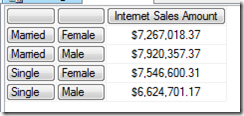The rather-too-many ways to crossjoin in MDX
Reposted from Chris Webb's blog with the author's permission.
In my last post I made the point that it’s a bit too easy to write and MDX query that works, even if you don’t really understand why it works, and in this post I’m going to address a similar issue. In MDX one of the commonest set operations is a crossjoin, and while most people understand what this operation does there are so many ways of writing a crossjoin in MDX that it can hurt readability and make the language even more confusing for newcomers. So what are all these different ways of crossjoining, and which one is to be preferred?
First of all, let’s look at what a crossjoin actually does. Imagine we have two sets, each with two members in them: {A,B} and {X,Y}. If we crossjoin these two sets together, we get a set of tuples containing every possible combination of A and B and X and Y, ie the set {(A,X), (A,Y), (B,X), (B,Y)}.
As an example of this, let’s look at the first way of doing a crossjoin in MDX: the Crossjoin() function. Here’s a query against the Adventure Works cube that returns the crossjoin of the two sets {Married, Single} and {Female, Male} on the rows axis:
SELECT {[Measures].[Internet Sales Amount]} ON 0,
CROSSJOIN(
{[Customer].[Marital Status].&[M], [Customer].[Marital Status].&[S]}
,
{[Customer].[Gender].&[F],[Customer].[Gender].&[M]}
)
ON 1
FROM [Adventure Works]
Here’s the output:
As you’d expect, you get four rows for each of the four tuples in the set: {(Married, Female), (Married, Male), (Single, Female), (Single, Male)}.
What are the pros and cons of using the Crossjoin() function then? Well, one thing it’s worth stating is that all of the different ways of doing crossjoins in MDX perform just as well as the others, so it’s purely a question of readability and maintainability. On those criteria its main advantage is that it’s very clear you’re doing a crossjoin – after all, that’s the name of the function! However, because it carries an overhead in terms of the numbers of brackets and commas and the name of the function itself, which isn’t so good for readability, and this is why I generally don’t use it. When you’re crossjoining a lot of sets together, for example:
SELECT {[Measures].[Internet Sales Amount]} ON 0,
CROSSJOIN(
{[Customer].[Marital Status].&[M], [Customer].[Marital Status].&[S]}
,
{[Customer].[Gender].&[F],[Customer].[Gender].&[M]}
,
[Customer].[Education].[Education].MEMBERS
,
[Customer].[Total Children].[Total Children].MEMBERS
)
ON 1
FROM [Adventure Works]
…you might need to look a long way up to the top of the query to find out you’re doing a crossjoin.
The most popular alternative to the Crossjoin() function is the * operator. This allows you to crossjoin several sets by simply putting an asterisk between them, for example:
SELECT {[Measures].[Internet Sales Amount]} ON 0,
{[Customer].[Marital Status].&[M], [Customer].[Marital Status].&[S]}
*
{[Customer].[Gender].&[F],[Customer].[Gender].&[M]}
ON 1
FROM [Adventure Works]
It’s more concise than the Crossjoin() function and I think easier to read; it also has the advantage of being the most frequently-used syntax. However there are rare cases when it can be ambiguous because an asterisk is of course also used for multiplication. Consider the following calculated measure in the following query:
WITH
MEMBER MEASURES.DEMO AS
([Measures].[Internet Sales Amount]) * ([Customer].[Gender].&[F])
SELECT {[Measures].DEMO} ON 0,
{[Customer].[Marital Status].&[M], [Customer].[Marital Status].&[S]}
ON 1
FROM [Adventure Works]
Are we crossjoining or multiplying here? Actually, we’re multiplying the result of the two tuples together, rather than returning the result of the tuple ([Measures].[Internet Sales Amount], [Customer].[Gender].&[F]), but it’s not easy to tell.
The third way of doing a crossjoin is one I particularly dislike, and it’s the use of brackets and commas on their own as follows:
SELECT {[Measures].[Internet Sales Amount]} ON 0,
({[Customer].[Marital Status].&[M], [Customer].[Marital Status].&[S]}
,
{[Customer].[Gender].&[F],[Customer].[Gender].&[M]})
ON 1
FROM [Adventure Works]
This is for me the least readable and most ambiguous syntax: in my mind round brackets denote a tuple and here we’re getting a set of tuples. I’d therefore advise you not to use this syntax.
Last of all, for maximum MDX geek points, is the Nest() function. Almost completely undocumented and unused, a hangover from the very earliest days of MDX, it works in exactly the same way as the Crossjoin() function:
SELECT {[Measures].[Internet Sales Amount]} ON 0,
NEST(
{[Customer].[Marital Status].&[M], [Customer].[Marital Status].&[S]}
,
{[Customer].[Gender].&[F],[Customer].[Gender].&[M]}
)
ON 1
FROM [Adventure Works]
Of course you’d never want to use it unless you were either showing off or wanted to confuse your colleagues as much as possible…
In summary, I’d recommend using the * operator since it’s probably the clearest syntax and also the most widely-accepted. Equally importantly, I’d advise you to be consistent: choose one syntax, stick with it and make sure everyone on the project does the same.
 |
Chris has been working with Microsoft BI tools since he started using beta 3 of OLAP Services back in the late 90s. Since then he has worked with Analysis Services in a number of roles (including three years spent with Microsoft Consulting Services) and he is now an independent consultant specialising in complex MDX, Analysis Services cube design and Analysis Services query performance problems. His company website can be found at http://www.crossjoin.co.uk and his blog can be found at http://cwebbbi.wordpress.com . |
Tags: mdx

